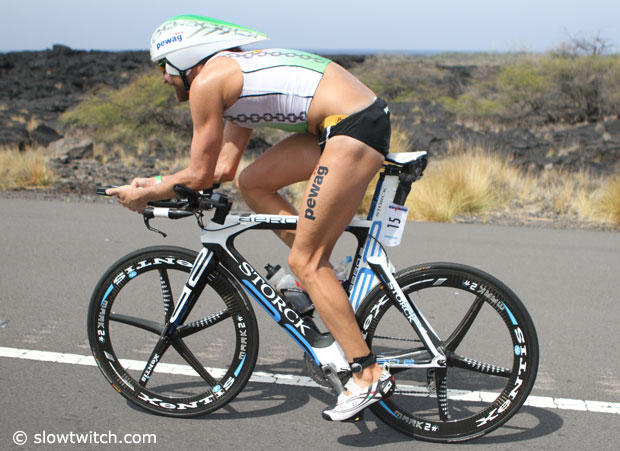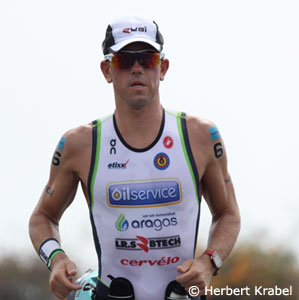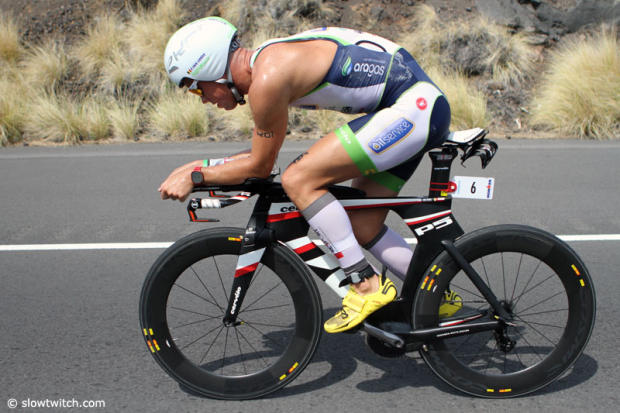McKenzie vs Al-Sultan – power
The crew at TrainingPeaks allows us again an inside of power numbers. Today we look at the data recorded by Aussie Luke McKenzie and German Faris Al-Sultan with the insights of AJ Johnson.
You can see the complete files of Luke McKenzie and Faris Al-Sultan on TrainingPeaks.com.
The 2013 Ironman World Championships was again a test of pacing, patience, smarts and fitness. Australian Luke McKenzie put together a great day to come in second, and crowd favorite Faris Al-Sultan notched another top ten performance. Here we take a look at their power data in an attempt to see how the race played out and learn from the numbers.
McKenzie and Al-Sultan came out of the water within two seconds of each and in the large main pack. From the start there was a large group dynamic with fifteen to twenty men all in a pack. Up Palani, Al-Sultan pushed 356 watts, 5.03 w/kg and 98% of his Functional Threshold Power (FTP) for 4:43. McKenzie cranked out 323 watts, or 4.45 w/kg., 92% of his FTP for 4:52. At the time, Al-Sultan was ahead of McKenzie. Both riders stayed in the rotating pack behind Andrew Starykowicz.
Through to Hawi not much changed. Starykowicz stayed out front while the chase pack did some rotating. For the first 56 miles McKenzie hammered out 277 average watts (3.8 w/kg), 13 less than he did in 2012. Interestingly, for that stretch McKenzie has a Variability Index (VI) of 1.07, well above what we would normally see from the pros. Likely this was the Aussie punching it over the rollers and keeping the pressure on. Al-Sultan on the other hand held 293 (4.1 w/kg) watts but had a more steady VI of 1.03 for the first half of the bike.


Up to Hawi both Al-Sultan and McKenzie were strong. On the climb to Hawi McKenzie upped his watts to 328, or 4.52 w/kg. Interestingly enough, Al-Sultan also put out 4.52 w/kg powering 320 watts. The only changing factor was the hard charging Kienle. He was going to catch the front, the only question was how long would it take and who would he take the lead from?
It was on the return from Hawi that things started to finally break up. Starykowicz was still up the road, but McKenzie started to inch closer to him and pull away from Al-Sultan and other contenders. Descending from Hawi the two riders again were almost equal. Al-Sultan put out 275 watts (3.96 watts/kg) and McKenzie again was nearly identical at 272 watts (3.75 w/kg).
As McKenzie was lighting up the front, Al-Sultan was slowly fading. Had he put too much energy out to stay at the front? It’s hard to say but his power numbers start to drop here. After the descent from Hawi riders face a short but difficult climb to Kawaihae. Here McKenzie was able to see Starykowicz up the road and he stayed on the gas, covering the .9 mile climb at 350 watts, 4.82 w/kg. Al-Sultan tackled the same climb at 331 watts, 4.68 w/kg. A subtle note – this is the first time McKenzie was putting out more watts per kilogram than Al-Sultan.
Not waiting for Kienle, McKenzie passed Starykowicz into the lead near mile 75. To make the pass, McKenzie cranked up the watts to 405, an astonishing 5.58 w/kg, for 33 seconds. Was he going too hard? Would he implode on the marathon? Ultimately the answer was no, but no one knew that at the time.
It was after Kawaihae that McKenzie put time into Al-Sultan and others in the chase. Swapping the lead with Starykowicz, McKenzie powered out 277 watts, or 3.82 w/kg for the 33 mile post-Kawaihae stretch. On the other hand, Al-Sultan continued to fall back. His power average for was 257 watts, or 3.63 w/kg for the same stretch. Time wise, that worked out to a 4:30 advantage for McKenzie. In talking with McKenzie after the race he mentioned that it was here that he really started to look more closely at his power numbers. Previously he was contending with other men, but now that he was at the front and he used the Quarq to keep things in control. A great example that McKenzie pointed out was when Starykowicz passed him back for the lead. Looking at his Quarq he saw numbers that were too high for him (he mentioned 320 to 340 watts), and he felt that Starykowicz was trying to drop him. McKenzie played it smart and kept his effort in check, not fighting for the lead at that point.


Amazingly, McKenzie actually put out more watts, 285 (3.93 w/kg) during the last 56 miles, 8 more watts than on the way out. That wasn’t exactly McKenzie’s plan, but with the wind conditions and race dynamics of the day it worked to his advantage. McKenzie attributes his ability to maintain a high power output in the second half to a renewed focus on bike fitness after a 2012 season where he had focused on improving his run. Part of his bike training included becoming more efficient through increasing his cadence, doing some motor pacing at 110 rpm. As a result he averaged 93 rpm this year vs. 74 rpm last year.

Learning from last year, McKenzie made some changes to his training and executed a great plan.
His patience and power took him to a career best second place finish in Kona. Al-Sultan had a solid day as well, but at the pro level just 1 or 2 % is the difference between second and tenth.
Stay tuned for a comparison of Linsey Corbin vs. Meredith Kessler’s Kona power data.





